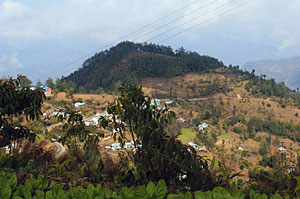 Travis Price's Spirit of Place meeting house in Finland, inspired by the epic 'Kalevala' |
Stirred by such comments from the villagers of Namje and Thumki, I rubbed my eyes and looked around their landscape again. It was very different from the first images that had introduced me to Nepal, as a Peace Corps volunteer a decade ago. There were few signs of the water shortage that had propelled my work with the community. Was easier access to water now one of the key drivers of modernisation? About 10 new homes had cropped up in the last 3 years, and the school buildings had expanded to accommodate a +2 campus. The bumpy roads had been smoothed out by the increasing traffic.
Before me lay not a village, but a rapidly developing townscape.
For my wife Priyanka and myself, these villages have been a microcosm of our understanding of the larger pursuit of development proliferating throughout the country. The infrastructural growth that began with roads in the 1950s has brought a certain version of modernisation to Nepal, which has seen traditional, cultural ways of life associated with backwardness and poverty. Developing the human connection to land and spirituality is not considered development at all. With hundreds of villages now becoming homogenous concrete-built communities, the current need is not just for water or schools, but also for newer ways to create the built fabric embedded into the history and culture of communities.
In our quest to find a solution to this problem, we met architect Travis Price, the founder of Spirit of Place-Spirit of Design, to bring his award-winning design-build program to Nepal. Captivated by the images of his timeless structures embedded in different landscapes, we can only imagine what excitement his architecture will bring to the villages. In The Archaeology of Tomorrow, Stanley Hallet notes, "His work seeks to recognize the importance of cultural myth informing the very fiber of our bodies; it colors, shades and transforms how we perceive and find meaning in the world that surrounds us."
Travis Price is not so focused on building with natural materials as he is with playing with nature in ingenious ways. This year, he and his students at the Catholic University of America will bring their provocative ethos to Thumki village. They will seek to develop a new aesthetic archetype that embraces the village's modern pursuits and the rich ancestry of indigenous peoples and their sacred geographies.
 PRIYANKA BISTA SEEKING SPIRIT: Thumki hill from Namje, Dhankuta district |
It is here that Spirit of Place will build its 18th legacy marker, which will both commemorate Thumki's ancestral spirits and symbolise its modern future. The students will also help design the townscape in order to reproduce a similar aesthetic. Travis Price notes, "We hope to stir the spirit not only of the villages of Namje and Thumki, but indeed set a new vision that even encroaching development can emulate."
Finally, after 10 years of working here, I feel that the project is moving forward.
Rajeev Goyal, co-written with Priyanka Bista


